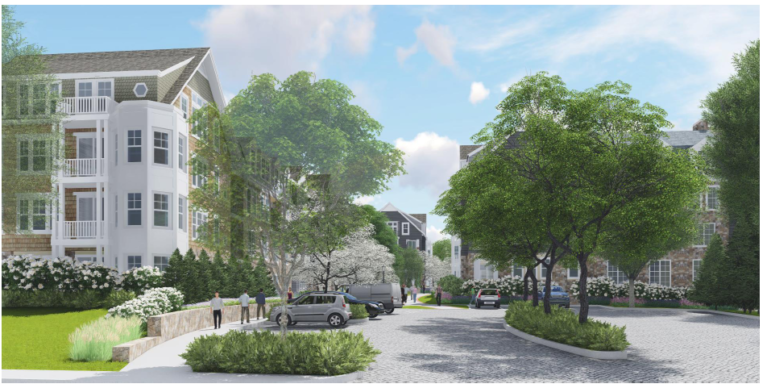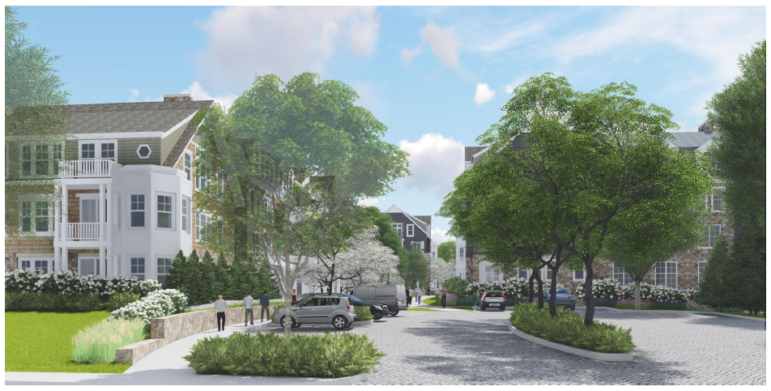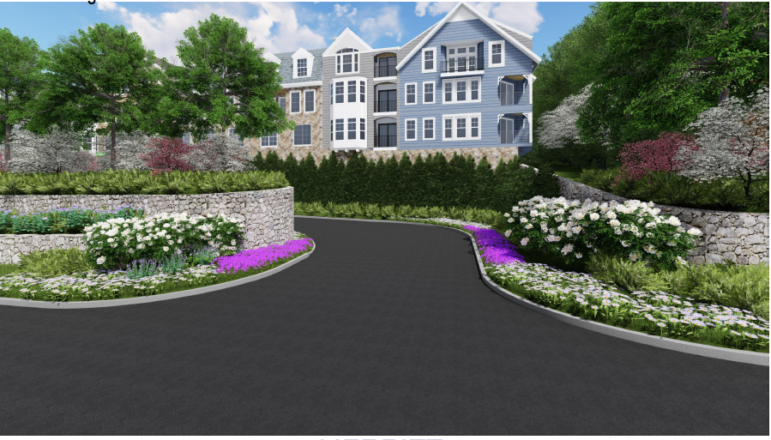New Canaan could use an increase in its in-town housing supply, for seniors, young professionals and, in some cases, families, the head of the Planning & Zoning Commission said Tuesday night.
Some families want to live in town and “we can’t tell them where to live,” P&Z Chairman John Goodwin said during the commission’s first discussion of the divisive Merritt Village application since the public hearing on it closed.
“I am not convinced that there will be an influx which would overwhelm the schools—I just don’t see the demographics going in that direction and the applicant put on the record some demographics there, so some sort of huge school enrollment spike—I am just not convinced,” he said during the meeting, held at Town Hall.
“I am convinced that a vibrant town needs to meet the demand and the demand right now is for some in-town housing and I know there is a view that New Canaan should ideally never change—I would love that, too, but the reality is that towns do change and I think quite frankly that we have to worry right now about our village. There is a company called Amazon which is the leader in taking share of retail sales. So quite frankly, I worry about how our village stores will continue to be successful. I do not want to end up being a town of restaurants [alone]. So a little additional population in town to satisfy demand—I think quite frankly there are some additional benefits there. So towns change and what we are trying to do is guide this, and again, we can’t tell people want to do, the best thing we can do is guide and that is what we are trying to do right now.”
That said, Goodwin added, “the applicant disputed this, but I do believe that [the project could set] precedent in terms of what is the density in developments in town.”
For the size of the Merritt Apartments’ approximately 3.3-acre lot, “up around 85 to 95 units is equivocal to the maximum, most dense development we have got in town.”
Noting that the would-be developer plans to install 116 units there (down from 123 in the initial application), Goodwin said, “I certainly feel that this property was underutilized, so there should be a larger project there, so my ideal would have been 85 to 95 units.”
He spoke during the first hearing since public comment on Merritt Village closed. The divisive proposal underwent six public hearings starting in the summer. Plans call for 116 units—55 condos, 61 apartments—in townhouse-style buildings would rise 3.5 stories where the 38-unit Merritt Apartments now stand (roughly between Maple and Park Streets, catty-corner to the library).
Goodwin said he would prefer the commission to come to a unanimous decision. Ultimately, P&Z continued the matter to a future special meeting that will be scheduled for some time prior to its regular Nov. 29 meeting.
The commission has until about Dec. 8 to render a decision on the application filed on behalf of property owner M2 Partners. That’s about one month before New Canaan expects to qualify for an exemption from the Affordable Housing Appeals Act—a state law often called by its statute number, “8-30g,” that would allow a developer such as M2 Partners to skirt local planning decisions by designating 30 percent of the units in a given development as “affordable” under the state’s definition.
The specter of an 8-30g application loomed over the closed hearing—more on that below.
During past public hearings, opponents to Merritt Village voiced concerns about its height (originally four stories), density, affect on real estate values, potential for increasing school enrollment, bringing unwanted traffic and changing the closely guarded look and feel of New Canaan. Opponents often said they do not believe the findings of third-party consultants—including those commissioned by P&Z on M2 Partners’ dime—who studied traffic, real estate valuation and neighborhood impact.
Advocates of the project have said it would create sorely needed housing for seniors seeking downsized, single-level living within walking distance to the downtown and train, and meets several directives outlined in the Plan of Conservation and Development, which is meant to guide development in New Canaan.
At its meeting Tuesday, P&Z weighed proposed text changes to the New Canaan Zoning Regulations, as well as a proposed change to zoning boundaries on Park and Maple Streets, both of which are needed to make the Merritt Village development possible.
In order to approve the overall project, site and special permit applications from property owner M2 Partners also would need to gain favor from P&Z.
P&Z took the opportunity of the first closed hearing to get a sense, commissioner by commissioner, of where its members stood as deliberations started.
The commission referred during its deliberations to a set of conditions drafted by Kleppin—the former New Canaan town planner who is staying on through the Merritt Village application in a consulting capacity. Though not made available publicly (they’re still in draft form), the conditions appeared to limit the number of units that would be allowed for Merritt Village to 105, based on what P&Z commissioners said.
During much of that discussion, commissioners broached the possibility that M2 Partners—if denied or unhappy with the conditioned approval of its application—could file anew under 8-30g.
Town Attorney Ira Bloom advised the commission that such an application is possible, saying “that sets us off in a very different direction” from a modified application or an appeal in state Superior Court if denied.
“Your options in an 8-30g application are much more limited because the law shifts the burden to the commission,” Bloom said. “Whereas with a normal application—what you have now, if you choose to deny it, it is the applicant’s burden to show in court that you did something illegal, arbitrary or unreasonable, under 8-30g the burden shifts to the commission to provide why it did what it did. The burden is quite high.”
Specifically, Bloom said, the commission would have to meet a “very limited” standard that there is “significant and substantial public interest” in denying a project that includes affordable housing.
“It is not uncommon at all for a particular applicant who is unhappy and feels he or she is out of options to go with the 8-30g route, and then the rules change and the burden shifts.”
New Canaan falls well short of a state standard, under which 10 percent of all housing stock in town qualifies as “affordable” under the Connecticut Department of Economic and Community Development’s definition. The town expects to achieve a four-year moratorium early in 2017 when a Certificate of Occupancy is issued for the more densely built affordable housing complex at Mill Pond. A second phase of that project is expected to get New Canaan a good way toward another four-year moratorium, and officials now are looking at Canaan Parish as a possibility for creating even more units.
It’s unlikely that New Canaan ever could achieve the 10 percent threshold. Goodwin noted that Merritt Village conceivably could have come in as a 200-unit project “and we would still have a problem defending ourselves.”
“At one point in time, the applicant before filing an affordable housing application was at 160 units, so you know what guys? We made a heck of a lot of progress here,” he said. “So I started to think about this and we are not at a number we would like to be but we made a lot of progress. I do feel that 8-30g is a real and present danger. So we could deny this thing and we would be heroes for a day, but quite frankly there is some probability that the applicant would come back with 8-30g and I think it is not a good idea to play that game of chicken if we can get to a project size with the applicant that is OK from our perspective as well.”
Commissioner Dick Ward said he suspected the applicant would not “be too crazy” about filing such an application, especially given the quick turnaround time it would require, with the imminent completion of the first part of the Millport Apartments rebuilding.
“It would be sort of a last resort,” he said.
Some commissioners hazarded the opinion that making Merritt Village an affordable housing project, where 30 percent of its units would be rented or sold as such, would compromise the developer’s ability to sell the other 70 percent.
Commissioner Bill Redman said the group would prefer “to do the right thing by the town” and added: “I do not think any of us want to see an 8-30g go up in there, and I personally do not.”
He said the conditions drafted by Kleppin appear to be getting the town to a viable middle ground.
Commissioner Claire Tiscornia said: “As for affordable housing, I do think this town does need some affordable housing for people—that is my two cents.”
During the hearing, Goodwin called for a sense of P&Z on the Merritt Village proposal.
Citing the view of the development from Park Street, commissioner Jack Flinn said he would like to see no four-story buildings at Merritt Village, even if it means expanding the footprints of some of the building. Commissioner Elizabeth DeLuca agreed with Flinn and said she additionally was concerned about the visual impact that the project would have from God’s Acre.
Commissioner Dick Ward said he disagrees with anyone who claims that the town’s zoning regulations are “sacrosanct” and never should be changed.
Commissioner Claire Tiscornia observed that many people appear to favor adding much-needed senior housing and then “get very upset” when a proposal that would accomplish that goal comes forward. Tiscornia added that she was concerned about adding four-story buildings and the density of the proposal.
Commissioner Laszlo Papp commended the applicant for responding to P&Z’s questions and concerns, and commended Kleppin for doing “a very good job drafting these possible conditions.”
Commissioner Kent Turner said that he was “torn” because the density “is quite high,” but that “there are a lot of good benefits” of Merritt Village. They include creating more needed housing that is adjacent to the train station and in alignment with New Canaan’s Plan of Conservation & Development.
“I think the benefits are stronger or outweigh the density issues and I am feeling positive about the process—the concessions that the developers made—and I think with the appropriate conditions, we could have a win-win for everybody.”



I don’t think the P & Z are on the right track. Their mode of thinking is counter productive. The more people in this small area will create more problems that are not being seen. Just think for a minute the crowding of the schools and traffic congestion, more possibility for rising crime. Look at the big cities, is this what we want? I have lived here for over twenty years and seen the Elm St. turn into a New York fifth ave. Parking is like trying to find a needle in a haystack. A recent article in the Advertiser wrote about the fact that the shop employees are taking up spaces along Elm St. leaving none for shoppers. So lets make in worse by putting more and more people in an already booming over grown town. I don’t feel that the P & Z is thinking from the brain but from the wallet…
So NJ is the real issue a need for a structured parking garage near the train that provides/obliges employee parking.
Stop stuffing more houses into this small and wonderful town …
Chairman Goodwin comments are most disturbing. Since he is a business person his depth of thought on the state of and remedy for New Canaan retail is incredibly sophomoric.
About ten years ago the New Canaan Chamber of Commerce was highly dysfunctional. At that time I served as president of New Canaan Village Association. When Tucker became head of the Chamber, we merged. Tucker has done a good job but there is not enough big thinking being done to remedy the fall of New Canaan retail.
One of the important things we did was to initiate the New Canaan Holiday Stroll.
Many other Towns have moved forward and are thriving. One thing to comment on here is our retail cost structure of rents, taxes, and usually maintenance is based on a pre-internet model. The internet effect has obviously been a huge shift in shopping traffic which leaves us with an unprofitable profit model. For the present structure to be healthy you have to figure out how to replace the literally tens of thousands of patron visits that have been lost or cut the cost structure.
Building 100 apartments or even a thousand will have no effect to remedy this problem as Mr. Goodwin’s comments suggest. Maybe he is placing the monetary benefit at the wrong feet (big dollars for developers/pennies for merchants).
New Canaan P+Z Commissioners should not blame Amazon but instead focus on the advantages of our town’s current rivers of demand.
An example of rivers……the Glass House opened its doors around the beginning of New Canaan’s retail decline. The Glass House now brings in 20,000 unique visitors a year. I am curious to know what the annual visitor count is with Grace Farms.
We should be studying the appeal of places like the Glass House, Grace Farms and other positive traffic builders (Caffeine and Carburetors) in our Town. Changing our zoning in a folly of misguided business principles will not generate New Canaan’s downtown retail businesses. Businesses will continue to close and Merritt Village will do little to stimulate the economic needs of the local shops.
I agree with Jack in that who’s to say the new residents of Merritt Village wouldbe any more willing to shop locally instead of on Amazon!? If local merchants cannot make up for price differentials with outstanding service and unique but desirable products, residents of Merritt Village aren’t likely to be patrons any more than current residents.
Agree with all previous comments. Merritt Village will not solve the business woes of downtown. With 212 parking spots (many underground and tandem), St. Aloysius’ Parking lot will be overrun by MV visitors —not parishioners.
Nor will the price of these condos solve the need for senior housing since most seniors who want to remain in New Canaan will not be able to afford it.
The Pedestrian Oriented Multi-Family Zone (POMZ) special permit that M2Partners is seeking in order to build the 115 units was designed to “preserve health, safety, property values and the residential character of New Canaan”. Will anyone here purchase a condo from the abutting neighbors? Traffic near Maple and Park is congested without the addition of Merritt Village. It will negatively impact our schools, traffic and quality of life. Over half of the present renters in the Merritt Apartments are gone. Many have left New Canaan.
Finally, the Plan of Conservation and Development does not specifically define higher density housing in the downtown area. That is to say, it does not mandate 212 parking spaces (double the parking spaces allowed in the Morse Court Parking Lot); nor does it mandate 115 units of housing. Higher density can be 50 units with 100 parking spaces.
Let’s be clear about it: Merrit Village project will not address affordable housing issue in New Canaan. On the contrary, it will add “unaffordable” housing stocks and make it harder for the town to meet the 10% goal. The 8-30g issue is simply used by the developer as the blackmail of the last resort.
Will the project help seniors to remain in town? How many seniors will sell their ranch houses and move into million-dollar-plus condos with 3-4 stories? I don’t think so. The most likely buyers will be young family with kids, potentially increasing school enrollment demand.
If the P&Z committee is rational, it should reject M2’s current application and wait for somebody with a more thoughtful plan that has lower density and better preserving town characters.
The SOBERING statistics: New Canaan needs about 556 more affordable apartments to meet the 10% quota (10% of 7551 homes = 755. We currently have 199 apts (2.64%) as of 2015. This means SEVEN 80 UNIT Housing Complexes – the size of new 3 story Mill Pond project. This will be done over New Canaan over the next 10 years according to P&Z’s plan. Source: pg 3 http://cdm15019.contentdm.oclc.org/cdm/ref/collection/p128501coll2/id/409155 affecting the character of the Village.
Once NC reaches it’s quota – developers cannot use AH to change zoning laws to their needs not the community. Using accessory apts all thru town has much less impact on town character if the 10% quota is chosen (vs challenging it). 2 Sample Losses from the AH threat: 1. 10 Acre Mill Pond Park (Avalon) 2. Historic Jelliff Mill was demolished and expensive”cluster housing” (10 homes in 8 structures) were built on 2 acres after the 1755 home (before the US revolution) was destroyed. The Town lost a lot of history and no affordable housing (actually the town asked these developers to contribute $200,00o to the AH fund – but this type of payment to get zoning changes may encourage bad behavior). We are smarter than this. Residents are smarter than to put up with this.
Edit to stats above – should say “This will be done over New Canaan over the next 40 years according to P&Z’s plan.” Build roughly 45 to 55 new units every four years to stave off outside projects through the 8-30g moratorium